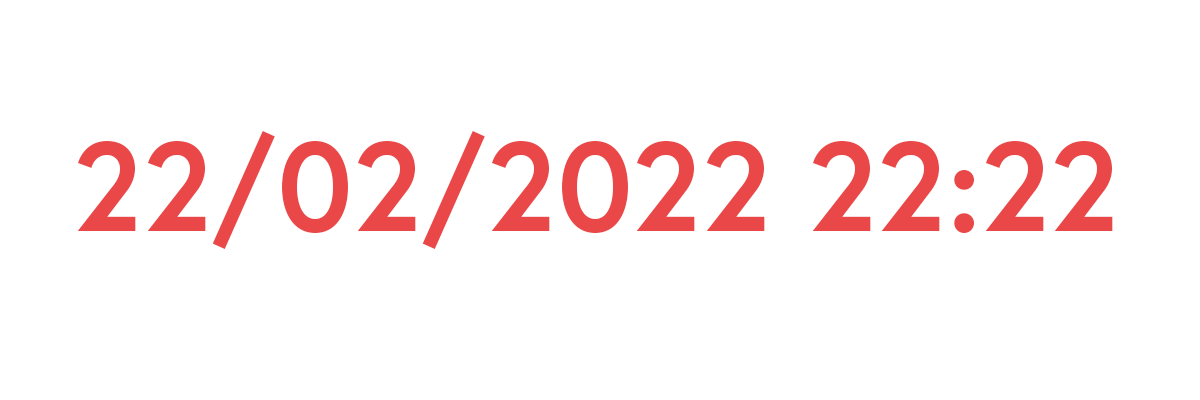
Twosday's hidden analogue symmetry
22:22 is palindromic and ambigramic, but what about its analogue form?
Intro
Yesterday, 20th Feb 2020 was supposedly Twosday (opens new window), both a palindromic (opens new window) and ambigramic (opens new window) date – at least on a calculator – and was celebrated (opens new window) by number nerds everywhere (myself included!).
However, those of us who get really geeky over times were hanging out for the double-whammy of 22:22 on 22/02/2022!
I got a Full House on #Ambigram Day yesterday!
— Dave Stewart (@dave_stewart) February 23, 2022
Note the battery; it took a day of meticulous planning and power management and an evening of telling people to go away and not bother me 😆#Twosday #TwosdayTuesday #22022022 pic.twitter.com/Pobe5HpLGs
22:22 has been my favourite time for a number of years now, because in addition to the digital symmetry, there is seemingly an analogue symmetry – the hands of the clock look like they are in direct alignment:

So the question is: does 22:22 – and therefore Twosday – have an analogue symmetry hidden inside its digital one!?
Theory
Conjecture
If you consider the hands of the clock:
- at 10 o’clock, the hour hand is ⅓ before the 12
- at 20 past, the minute hand is ⅓ before the 6
But at 22:22 the proportions cannot be thirds because both hands will have travelled a bit further (by 22/60) so:
- the minute hand will be 22/60 away from 12
- the hour hand will be 22/60 between 10 and 11
So the question is: with these additional small offsets, do the hands line up to 180°?
Proof
The way to think about the problem is to imagine the minute hand driving the hour hand.
For every minute that passes:
- the minute hand moves by 1/60 of 360°
- the hour hand moves by 1/60 of (360° / 12) or 30°
Therefore at 22:22:
- the minute hand will be at 22/60 x 360 degrees
- the hour hand will be at (10/12 x 360 degrees) + (22/60 x 30 degrees)
If you subtract one from the other you get the difference in degrees between them… which we hope is 180°.
Code
Attempt 1: solving for 22:22
I like to solve things in code, so in JavaScript:
var f = 22/60
var t = 360
var m = f * t
var h = (10/12 * t) + (f * 30)
console.log(h - m)
The result is 179.
So clearly, this is very close, but not 180!
Attempt 2: solving for 22:22:22
But what if we used 22 seconds as well? And how do we do that?
Well, 22 seconds as a fraction would be 22 / (60 x 60) or 22 / 3600, so the code is:
var f = (22/60) + (22/3600)
var t = 360
var m = f * t
var h = (10/12 * t) + (f * 30)
console.log(h - m)
And the result is: 176.98333333333335.
This feels very strange, that such a small adjustment would not only seemingly have such a large impact, but would move the value further away from the magical 180.
At this point I’m thinking my simple code experiments need some kind of geometric proof, so I can see the angles and start tweaking visually.
Attempt 3: solving for 180°
Luckily, I found some clock code online (opens new window) that I could quickly edit and create something more interactive.
Tweaking the time value, it was surprisingly easy to work out what time would give 180°, and that time was 22:21:45 as you can see in the interactive example below:
But here’s the thing…
If we round off the time to just the minutes (which was our original aim) we get 22:22 and 180° !
Conclusion
If you’re happy to accept the rounding then 22:22 on 22/02/2022 has multiple embedded ambigrams and palindromes:
- the digital date: 20/02/2022
- the digital time: 22:22
- the analogue time: 180°
Is the 180° strictly pure? No, but by that token, is the date? The leading zero in the month component could have been omitted, but we wouldn’t be having the fun we are now. It’s all a fudge really, you just have to enjoy it for what it is.
Happy Twosday!





